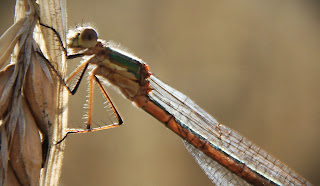The first thing I noticed was that while you expect to see wildlife everywhere, it is actually quite difficult to spot it and so you have to uber-concentrate in order to spy a potential wee beastie. Once I had spotted a little critter, I quickly hurried over with my heavy footed size 10s and whatever it was that was lurking there, quickly disappeared into the long grass. This happened over and over and an hour in without a single photograph was starting to become frustrating. Therefore, I would have to become one with the world and dust off my ninja skills...'crouching Neil, hidden dragonfly'.
I had been chasing a butterfly for quite some time, but trying to get a photo of one was proving near impossible for me...but I did get close...ish!
OK, this wasn't going into National Geographic, so I decided that the quick moving and shy insects were too well adept to spotting me. So I would pick off some slow moving bugs if I could find them and gradually improve my skill at sneaking up on them.
So I managed to sneak up on one of the slowest I could find! :) This little fella didn't have much choice about being photographed! If I couldn't shoot a butterfly, I would shoot one before it became a butterfly!
The problem was that to get any decent close up images of bugs, means you need to shoot with a macro lens, this in turn means you need to get fairly close to the subject in order to photograph it...this is the point that they usually scurry/fly away.
The second problem with shooting a macro image is that you have a really shallow depth of field. It is so shallow that the front end of a bug can be in focus while the back end is out of focus. Now add in a multitude of variables like the wind blowing the grass reed that the bug is sat on, your breathing while holding the camera, the bug moving, bad balance while crouching, and you will end up with a soft image on the focal point. This is a real pain when you might only get one chance to photograph it before it hops off from the sound of the camera click.
After a lot of missed opportunities and many out of focus shots, I started to become a bit better at creeping up on the creepy crawlies and so I managed to get a few nice shots for my efforts.
I should also mention the light issue here as well. Flying bugs tend to move at a very fast rate, especially their wings. The common bee can beat it's wings up to 180 times per second, so if you want to capture it in mid-flight, then you really need to have a camera that can shoot at extremely high shutter speeds...if you don't, then the wings will have a blurred look to them.
After a while I started to capture the really fast and twitchy type of bugs I had been striving for, and here are the results.
Ultimately shooting insects turns out to be a really difficult thing to do properly and it was a real eye opener for me. However, it was a great exercise in shooting a different subject and having to think your feet and tread lightly at the same time. I would recommend anyone doing this who is interested in photography or cinematography, after all, all you need is a camera, great outdoors and a bit of patience.

































No comments:
Post a Comment
Thanks for your message, it is always nice to get feedback ;)